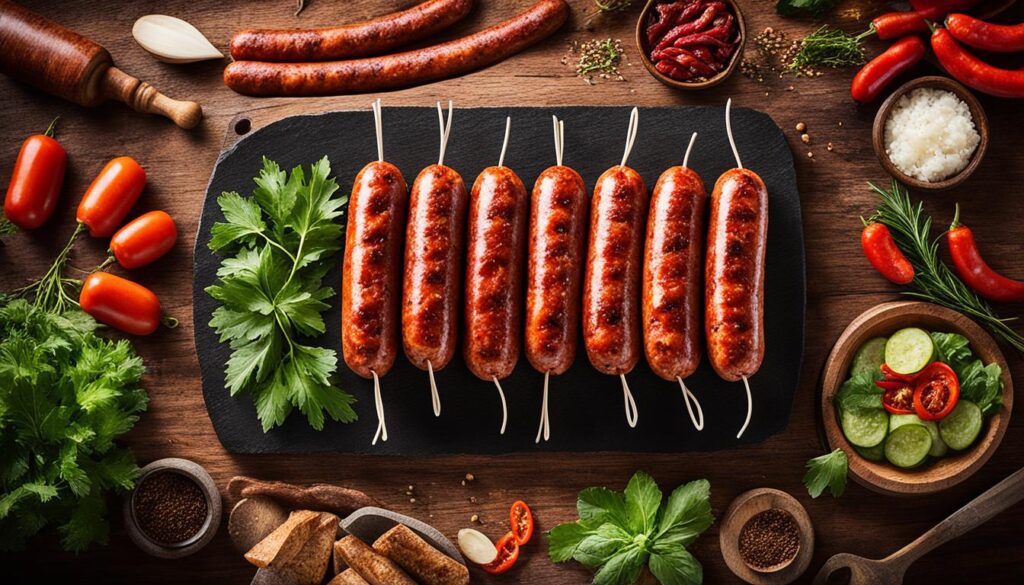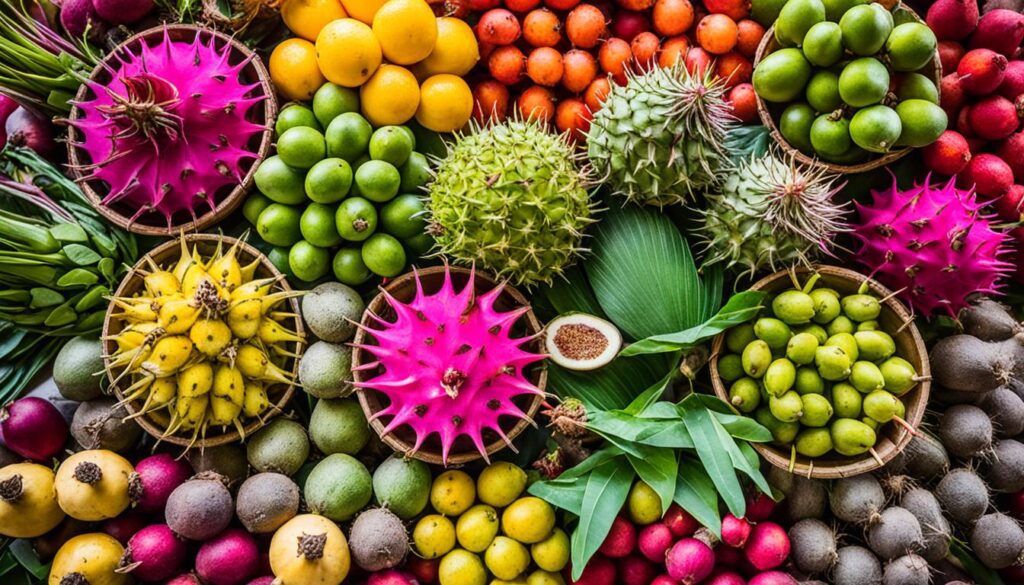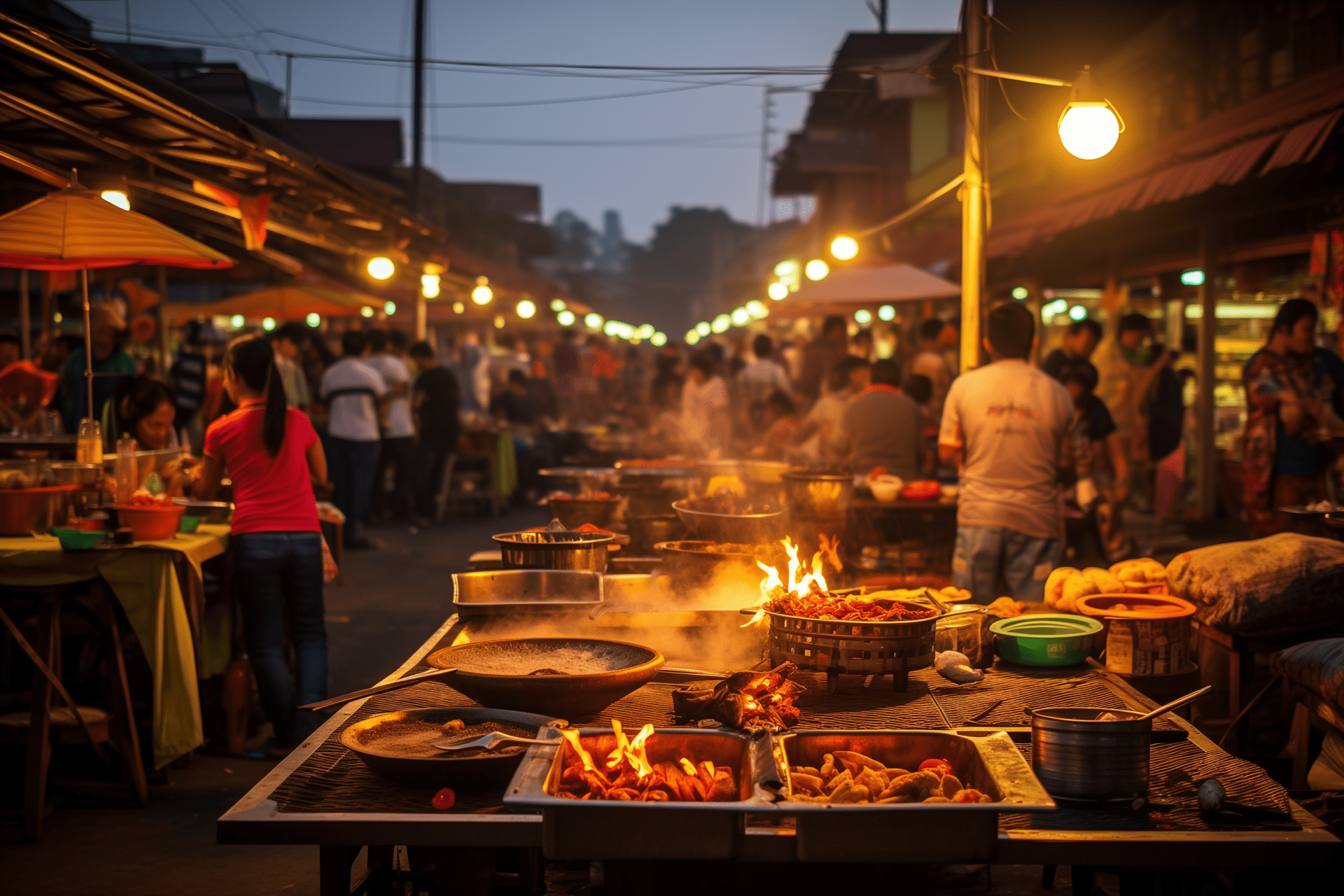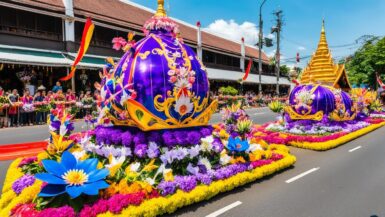Explore the rich flavors of Chiang Mai Cuisine with our guide to Northern Thai culinary traditions and must-try local specialties.
The allure of Chiang Mai cuisine goes far beyond the picturesque landscapes of Northern Thailand—it’s an epicurean journey that captivates the taste buds and offers a window into a rich culinary heritage. Known for its distinct flavors of Chiang Mai, this region’s gastronomy tells stories of centuries-old Northern Thai culinary traditions and the warm-hearted people who continue to honor them. With each bite of their local specialties, you’re not just tasting authentic Thai food; you’re partaking in a legacy of communal dining and locally sourced ingredients that are the heartbeat of Thailand’s cultural capital.
From the bustling street markets to the award-winning tables of restaurants like Kiti Panit, the cuisine here is a vibrant illustration of the city’s spirit. Whether you’re savoring the creamy coconut and curry fusion of Khao Soi or unraveling the spicy complexities of Nam Prik Ong, Chiang Mai’s gastronomy promises an adventure for those who seek to discover the true essence of Thai food. Join us as we explore the zesty, zingy, and ultimately unforgettable dishes that make Northern Thailand’s food scene an irresistible attraction for gourmands worldwide.
Key Takeaways
- Uncover the rich tapestry of Northern Thai culinary traditions that make Chiang Mai a food lover’s paradise.
- Discover the signature flavors of Chiang Mai, from the smoky tang of street food to the sophisticated nuances of fine dining.
- Learn what makes local specialties like Khao Soi and Nam Prik Ong embodiments of authentic Thai food.
- Gain insight into how traditional recipes and modern takes coexist in the dynamic Chiang Mai cuisine scene.
- Appreciate the importance of organic and locally sourced ingredients in crafting the unforgettable gastronomy of Chiang Mai.
A Journey into the Heart of Northern Thai Cuisine
Embark on a sensory exploration of culinary traditions that have shaped the food culture in Chiang Mai, where every dish narrates a story of regional heritage and gastronomic innovation. In this vibrant city, traditional Thai recipes are lovingly preserved, while creative spins on classic Northern Thai dishes reflect the dynamic nature of local food in Chiang Mai.
Food Culture and Culinary Traditions in Chiang Mai
The foundation of Chiang Mai’s food landscape is its deep respect for traditional flavors interwoven with the fabric of daily life. Here, food is more than just nutrition; it’s a celebration of continuity and community. The large array of regional recipes passed down through generations is a testament to Chiang Mai’s rich food culture.
From markets brimming with fresh, local ingredients to bustling street food stalls and serene temples where food offerings are made, the connection between cuisine and tradition in Chiang Mai is inseparable.
Traditional vs. Modern Northern Thai Dishes
While traditional Thai recipes remain cherished, Chiang Mai is not immune to culinary evolution. Chefs in the city are known for their prowess in merging time-honored techniques with modern twists. The result is a tapestry of dishes that honor the past while charting new territories of taste.
| Traditional Dish | Description | Modern Adaptation | Notable Restaurant |
|---|---|---|---|
| Khao Soi | A curried noodle soup enriched with coconut milk and served with chicken or beef. | Deconstructed Khao Soi with contemporary plating and textures. | Kiti Panit |
| Gaeng Hang Le | A Northern Thai curry with a rich mix of spices, often featuring pork belly. | Hang Le with sous-vide pork for added tenderness. | Lanna Heritage Restaurant |
| Nam Prik Ong | A spicy tomato and pork dip, commonly served with an array of vegetables. | Infused with imported tomatoes for a deeper flavor profile. | The House by Ginger |
| Sai Oua | This is a grilled sausage filled with herbs and spices, embodying the essence of Northern Thai flavors. | Reimagined with organic, locally-sourced pork and a side of artisanal relish. | Local Food Market |
In this age of culinary adventurism, Chiang Mai’s gastronomy remains a beacon of authenticity. Whether you crave the comfort of a traditional Khao Niaow or the thrill of a redefined classic, the city’s northern Thai dishes promise a journey of taste that resonates with the soul of local food Chiang Mai.
Exploring the Unique Flavors of Chiang Mai Cuisine
The labyrinth of flavors that shape Chiang Mai’s culinary identity is an odyssey of taste that one must embark on to truly understand the essence of this Northern Thai haven. This gastronomic adventure is deeply rooted in the key ingredients and authentic flavors that constitute the bedrock of local dishes, embodying the region’s vibrant culinary traditions.
Key Ingredients in Northern Thai Food
In the quest to uncover the soul of Chiang Mai’s local dishes, we encounter an array of key ingredients that are both quintessential and telling of the region’s culinary narrative. From the pungent zing of lemongrass to the fragrant aroma of kaffir lime leaves, each element brings forth an indispensable component of the authentic flavors found in Thai street food and regional delicacies alike.

Understanding the Balancing Act Between Spices and Herbs
With a culinary palette that ranges from the smoky notes of Sai Oua to the rich, savory broth of Gaeng Hunglay, Chiang Mai cuisine exemplifies the delicate balancing act between spices and herbs. The traditional preparation invites one to experience a medley of aromatic spices like cinnamon and star anise that infuse local dishes with depth and complexity, without overwhelming the senses.
| Ingredient | Flavor Profile | Common Usage |
|---|---|---|
| Mak waen peppercorns | Earthy, woodsy | Marinades for meats, spicy sauces |
| Lemongrass | Citrus, tangy | Soups like Tom Yum, Curry pastes |
| Kaffir Lime Leaf | Bright, lemony | Stir-fries, curries |
| Galangal | Pungent, sharp | Curries, Tom Kha soup |
| Aromatic Spices (Cinnamon, Star Anise) | Sweet, woody | Stews such as Gaeng Hunglay |
To traverse the realms of Chiang Mai’s culinary artistry is to indulge in a symphony of flavors where each ingredient is a note, each spice a rhythm, together creating a melody that sings true to the region’s storied gastronomical heritage.
The Influence of Geography on Chiang Mai’s Gastronomy
The northern highlands of Thailand, with their fertile lands and rich biodiversity, have blessed Chiang Mai with an incredible array of local produce, shaping the essence of its culinary identity. The terrain’s natural offerings are the backbone of local specialties that capture the heart of traditional Thai food. River fish provide fresh nuances to broths and grilled specialties, wild vegetables impart earthy tones to salads and curries, while jungle herbs offer aromatic lifts to the myriad of popular Chiang Mai dishes. It is here, where the geography speaks through taste, that food in Chiang Mai finds its unique voice.

The use of ingredients like banana flowers, fermented bamboo shoots, and Chiang Mai’s famous smoked chili has cultivated a range of dishes that are as vibrant and diverse as the landscape from which they hail. Culinary aficionados revel in the opportunity to experience dishes such as Nam Ngiaw, with its robust, smoky flavor profile, and the sour tanginess of Naem Mok, offering an adventure for the palate that is deeply rooted in the terrain and traditions of this Northern Thai haven.
| Dish | Main Ingredients | Flavor Profile | Originating Geography |
|---|---|---|---|
| Nam Ngiaw | Smoked chili, tomato, minced pork, rice noodles | Smoky, spicy, tangy | Chiang Mai Valley |
| Naem Mok | Fermented fish, minced pork, rice | Sour, umami-rich | Northern Highland Rivers |
| Khanom Krok | Coconut milk, rice flour, sugar | Sweet, creamy | Rural Lowlands |
| Larb Koi | Minced fish, roasted rice powder, local herbs | Savory, herbal | River Basins |
In each bite of these delicacies, one can taste the convergence of the rich soils, the temperate climate, and the lush greenery that define this corner of the world. By marrying local produce with time-honored cooking practices, food in Chiang Mai is more than sustenance—it’s a celebration of region and culture. The harmonious blend of geographic fortune and culinary prowess continues to earmark Chiang Mai as a destined spot for those who seek to savor the true essence of traditional Thai food.
From Street Food to Fine Dining: Eating Out in Chiang Mai
The kaleidoscope of flavors that makes up Chiang Mai’s vibrant dining scene caters to all manner of taste buds, from those craving a quick bite from a roadside vendor to those seeking the sophistication of fine dining. The local culinary landscape vibrates with a diversity that is deeply rooted in the city’s heritage, elevating it to a gastronomic destination famed for both its authenticity and innovation within Northern Thai cuisine.
Must-Try Street Food Experiences
Chiang Mai street food serves as a gateway to the array of food specialties this historical city has to offer. Begin your journey along Suthep Road, dotted with stalls where you can savor the iconic Sai Oua, brimming with flavors that are as much a treat to the senses as they are to the palate. Take the adventure further to Chiang Mai Gate, a hotspot brimming with piquant and richly-seasoned delights such as the fiery Nam Prik Noom, an experience deemed a must-try food in Chiang Mai for locals and travelers alike.
Top Restaurants in Chiang Mai for Authentic Thai Flavors
For those with a preference for a more serene dining ambiance, Chiang Mai does not fall short of options. Top restaurants in Chiang Mai, including the likes of Krua Lawng Khao and Huan Soontaree, embrace the essence of Chiag Mai food culture, offering dishes steeped in tradition and contemporary flair. Whether it’s relishing a bowl of lush, creamy Khao Soi or exploring the inventive takes on time-honored recipes, these establishments extend an invitation to indulge in the full spectrum of Northern Thai cuisine, enhanced by settings that range from elegantly casual to the epitome of culinary luxury.
FAQ
What are the key characteristics of Chiang Mai cuisine?
Chiang Mai cuisine, a subset of Northern Thai culinary traditions, is known for its robust flavors and unique use of ingredients like wild mushrooms, mak waen peppercorns, and other aromatic herbs. Dishes are generally more salty and bitter, with less emphasis on sweetness and spiciness compared to other regions of Thailand. Sticky rice is also a staple component, showing the region’s preference for heartier textures.
Can you recommend some traditional dishes to try in Chiang Mai?
Certainly! Don’t miss out on local specialties such as Khao Soi, a coconut curry noodle soup, the spicy and tangy Sai Oua sausage, Gaeng Hunglay pork curry, and Nam Prik Ong, a spicy tomato and pork dip. Each dish offers a true taste of Northern Thai flavors.
How has the food culture in Chiang Mai evolved over time?
Traditional Thai recipes and techniques in Chiang Mai have been preserved over generations. However, modern influences and the adoption of contemporary cooking methods have led to an innovation within the local food scene. Today, you’ll find a vibrant mix of the old and new, with chefs respectfully tweaking traditional dishes to create updated versions while staying true to the authentic flavors of Northern Thailand.
What are some must-try ingredients in Northern Thai cuisine?
Northern Thai cuisine incorporates a variety of distinctive ingredients such as lemongrass, galangal, kaffir lime leaves, and the regional mak waen peppercorns, which add a unique, zesty flavor to dishes. Spices like cinnamon and star anise also play an important role in imparting depth to meals.
Is vegetarian food readily available in Chiang Mai?
Yes, vegetarian food is quite accessible in Chiang Mai. Many local dishes can be made vegetarian-friendly by substituting tofu or vegetables for meat. There are also a number of restaurants and street food stalls dedicated to serving delicious vegetarian Thai cuisine that doesn’t compromise on flavor.
How do geographical factors influence the food in Chiang Mai?
Chiang Mai’s location in the highlands of Northern Thailand provides access to a wide range of fresh local produce like river fish, wild vegetables, and exotic herbs. These ingredients are central to creating the depth and authenticity found in regional dishes, reflecting the rich biodiversity and agricultural heritage of the area.
What are some can’t-miss street food experiences in Chiang Mai?
For a true taste of Chiang Mai’s street food scene, try the renowned Sai Oua sausage from a Suthep Road vendor, spicy Nam Prik Noom at Chiang Mai Gate, and the sticky rice-based treat Khao Soi from a bustling night market stall. Each offers a glimpse into the variety and richness of the local street food culture.
Which restaurants offer the best Northern Thai food in Chiang Mai?
For an authentic Northern Thai dining experience, consider visiting Krua Lawng Khao and Huan Soontaree, which are highly recommended and serve an array of traditional dishes. Each restaurant pairs its delicacies with ambiances that range from casual to upscale, ensuring an unforgettable culinary adventure.
Are there any food tours available that highlight Chiang Mai cuisine?
Yes, food tours are a popular way to explore Chiang Mai’s diverse culinary scene. These guided experiences can take you through local markets, street food stalls, and hidden gems, where you can taste and learn about Northern Thai cuisine from knowledgeable guides.
What type of food souvenirs should I bring back from Chiang Mai?
Look for spices like mak waen peppercorns, local coffee, Thai tea blends, and packaged Sai Oua sausages, which can make for excellent souvenirs. Additionally, Chiang Mai’s markets often sell handcrafted cooking utensils and traditional pottery that are perfect for food enthusiasts looking to bring home a piece of the local gastronomy.






Leave a reply